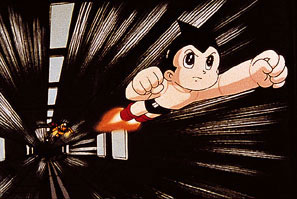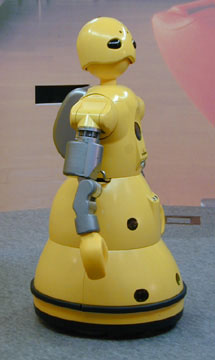Wakamaru Makes the Robot Dream a Reality
I staggered through the newsroom and into my office, still feeling effects from last night. Junior reporter Junko followed.
 "Well," she said, "we're showing improvement." She pulled out a pocket calendar and tapped her right foot.
"Well," she said, "we're showing improvement." She pulled out a pocket calendar and tapped her right foot.
"According to my notes, by this same day last year you had been jailed for public drunkenness eight times. Thus far this year, this morning makes it only six."
A small bubble of drool formed on my lower lip. I slouched into my chair, both eyelids half-closed. The lights weren't on.
Now at the edge of my desk, she said, "You know, the bail officer has my number on speed dial..."
She paused when she saw that my lips were moving yet no sounds were coming out of my mouth. But the lecture soon continued.
"While you 'gear-up' for today's tasks, give a look at my report on the latest in robot technology." She tossed a folder onto my lap. My arms remained dropped to either side of the chair.
Upon exiting, she flipped the light switch. With no cigarette within reach, I tipped my head back and simultaneously dragged the report over my face to shield the oncoming fiery breeze.
If he were alive today Tetsuka Osamu would certainly be proud.
Last week at Robodex 2003 in Yokohama, Wakamaru, a so-called "home-use" robot, spun, rolled, talked, and waved on Mitsubishi Heavy Industries' stage; all this, just days before the "birth" of "Astro Boy" (or Tetsuwan Atomu in Japanese) - the futuristic cartoon robot boy creation of Osamu from 50 years ago.
"This robot lives and interacts with human beings - to assist them," explains Tadashi Nagashima, project manager of the Wakamaru project, of his company's creation.
 But Wakamaru's means of assisting is a little different from that of his cartoon predecessor, who rocketed through space while defeating enemies. Rather, the function of Wakamaru - a 30-kilogram yellow snowman-shaped bundle of circuitry on wheels - is more geared toward basic household services: dispensing information, instruction, and simple comfort.
But Wakamaru's means of assisting is a little different from that of his cartoon predecessor, who rocketed through space while defeating enemies. Rather, the function of Wakamaru - a 30-kilogram yellow snowman-shaped bundle of circuitry on wheels - is more geared toward basic household services: dispensing information, instruction, and simple comfort.
While the appeal of most of the high-profile robots from Japanese makers is mainly limited to that of novelty as pets or toys (for example, Sony's AIBO), Wakamaru is a peek at the future that Osamu had in mind - that of robots working with people. Wakamaru utilizes the latest advances in technology to communicate with its masters, and, as a result, assist them. With Japan continuing to adjust to the graying of its population, technological innovations like Wakamaru might just be what the doctored ordered.
"Our idea is to pack all the best available technology inside Wakamaru," emphasizes Nagashima.
This includes the voice- and face-recognition systems used for communication. The latter is made possible through a pair of cameras. Also, speakers set within its lower chest area give Wakamaru its gender-neutral voice.
These days, the practical use of robot technology has generally been left for industrial applications in factories. For Wakamaru, its key selling point lies in heavy thinking as opposed to precision welding.
From controlling household appliances to communicating with doctors or other experts through email, Wakamaru will provide nearly any service required by folks getting on in years (exceptions being doing the windows and vacuuming).
 As a result of Japan's rapidly aging population and declining birthrate, Wakamaru's target consumer will be the expanding geriatric set. A recent estimate from the Nihon University Population Research Institute expects that by 30% of Japan's population will be aged 65 and older by 2025, a substantial increase from the 17% this same group represented in 2000.
As a result of Japan's rapidly aging population and declining birthrate, Wakamaru's target consumer will be the expanding geriatric set. A recent estimate from the Nihon University Population Research Institute expects that by 30% of Japan's population will be aged 65 and older by 2025, a substantial increase from the 17% this same group represented in 2000.
Flexibility will be a key if Wakamaru is to be a success. Nagashima maintains that while Wakamaru's 1-meter-tall exterior will likely remain intact over the course of its robot life, its software is fully expandable, allowing for upgrades as technological improvements are developed.
But don't be led to believe that this emphasis on electrical pulses and moving steel parts has resulted in a cold-natured bucket of components. That simply isn't so. Many of the subtleties of a regular person are in place: arms pivot or twist at the wrist, elbow, and shoulder to allow for gesturing; the head tilts from side to side during moments of ponder; and friendly querries are programmed into its speech patterns, such as: "Have you taken your medicine?"
In short, Wakamaru will be an unobtrusive member of the family, one who will remind you to finish your vegetables and adjust the air conditioning - all with a gentle twist of its sperical head.
There are of course some initial hurdles that Wakamaru will have to get its servo motor to wheel around before it is to become a fixture in the Japanese home.
Promotional videos show Wakamaru gliding freely on "barrier-free" carpets and wood floors, and not tatami. Nakajima admits that Wakamaru's wheels do tend to tear the centuries-old woven Japanese home interior hallmark but points out that Western-style flooring is slowly becoming the preferred option in new Japanese apartments. "Wakamaru really is then for those thinking in terms of the future," he laughs.
 Though the Linux operating system - an increasingly common choice by engineers due to its high processing power and flexibility - was chosen for Wakamaru's nerve center to eliminate licensing costs, its initial price tag will be in the range of 1 million yen. Since this hefty sum approaches that of a new car, consumers might shy away from such an investment in an economic environment that has seen purse strings grow tighter year-by-year.
Though the Linux operating system - an increasingly common choice by engineers due to its high processing power and flexibility - was chosen for Wakamaru's nerve center to eliminate licensing costs, its initial price tag will be in the range of 1 million yen. Since this hefty sum approaches that of a new car, consumers might shy away from such an investment in an economic environment that has seen purse strings grow tighter year-by-year.
In Mitsubishi Heavy Industry's corner is the fact that among the gloom of surrounding the future of Japan's economy, money in consumers' hands is not in short supply. Total personal savings amount to 1.4 quadrillion yen - the highest in the world on a per-capita basis. What consumers need - especially aging ones conditioned to continually salt away as much money as possible - is a reason to make a purchase, and Nagashima hopes the quality of his company's product will provide that incentive.
But at this stage, Wakamaru is unique given that robot rivals are non-existent at this point. Presently, other robots, like Honda's ASIMO humanoid (which provides reception services for companies) and Sanyo's four-legged Banryu security monitoring robot, might be seen as similar to Wakamaru but do not offer the same scope of services.
Mitsubishi Heavy Industries is hoping that its head start will fill this untapped home service niche. "We will make the market first," Nagashima says proudly. "Then maybe Sony and Honda will enter later."
With sales set to begin next year, Nagashima is cautious though about Wakamaru representing the robot dream of Osamu. "Astro Boy might exist in the next 50 or 100 years...but I am not sure. Wakamaru is the future - now."

